Stream 2- Broad Street Pump Outbreak
c: Photo Tour of Broad Street Pump Outbreak
No photo tour of John Snow's life would be complete without a stop at the replica of the Broad Street pump, unveiled on July 20, 1992 to commemorate the public health work of Dr. Snow.
THE BROAD STREET WALK
Introduction - Sites and Old Replica of Broad Street Pump
No photo tour of John Snow's life would be complete without a stop at the replica of the Broad Street pump, unveiled on July 20, 1992 to commemorate the public health work of Dr. Snow.
The Old Ordnance Survey map of 1870 for the Broad Street area is shown with several landmarks to be presented on our tour. We will go from right to left along Broad Street (now Broadwick Street), heading towards the old replica of the famous pump, since moved to a more appropriate location.
The first building is the former Lion Brewery, retaining the old name in the Old Ordnance Survey map. .
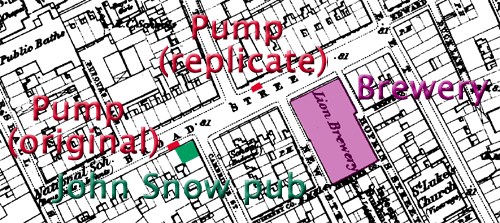
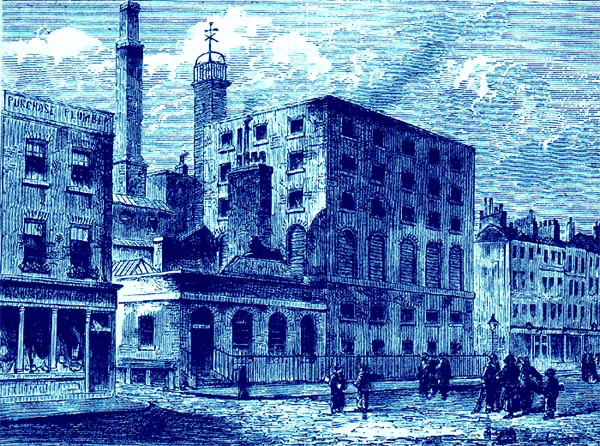
Source: Anonymous. The Lion Brewery, about 1850, in Walford, Edward. Old London: Haymarket to Mayfair. The Alderman Press, 1989.
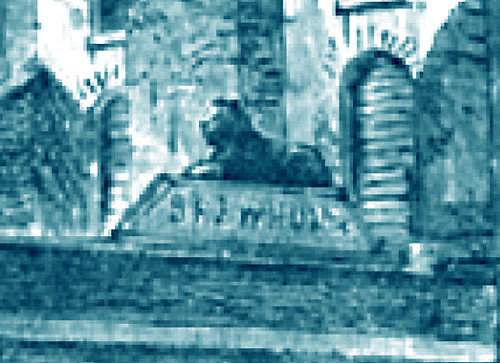
The Lion Brewery at 50 Broad Street featured a statue of a resting lion above the entrance. The company changed ownership in 1836, sold to Huggins and Co. Ltd, but may have maintained the existing building for some while.
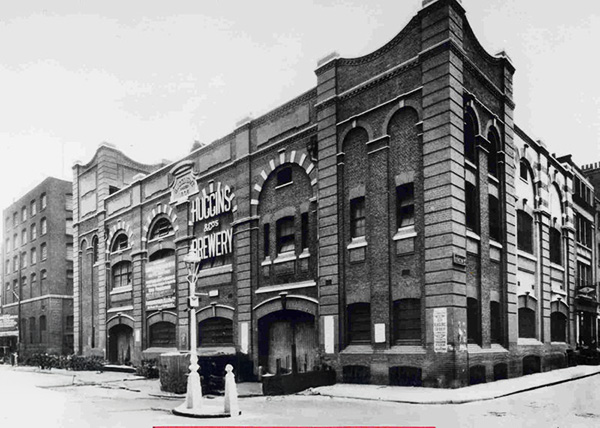
The name "Lion Brewery" had officially changed in 1836, when the previous owner opened a new brewery in Lambeth (by the River Thames next to the Lambeth Water Works) and took the Lion Brewery name with him. By 1850 (four years prior to John Snow's Broad Street Pump outbreak investigation), the Huggins family had taken full control of the brewery, but used the title, "Lion Brew House at Broad Street, Golden Square", eventually adding its official name of Huggins Brewery to a new building (at left in 1920s),
Exception in Investigation
In his book, Snow told of an interview he had during his "Broad Street Pump Outbreak" investigation with a spokesperson for the brewery. Snow wrote...
"There is a Brewery in Broad Street, near to the pump, and on perceiving that no brewer's men were registered as having died of cholera, I called on Mr. Huggins, the proprietor. He informed me that there were above seventy workmen employed in the brewery, and that none of them had suffered from cholera, -- at least in a severe form, -- only two having been indisposed, and that not seriously, at the time the disease prevailed. The men are allowed a certain quantity of malt liquor, and Mr. Huggins believes they do not drink water at all; and he is quite certain that the workmen never obtained water from the pump in the street. There is a deep well in the brewery, in addition to the New River water (provided by a company that pipes spring water from north of London, not from the polluted River Thames)."
- Snow, John. Communication of Cholera, 1855, p. 42
Snow's discovery that none of the 70 or more persons working in the Huggins Brewery developed cholera were far different from those living in other households in the immediate neighborhood, with one exception. Apparently all of the employees consumed water from a separate well maintained by the brewery, or drank only beer. Snow reasoned that they had no exposure to the water of the Broad Street pump, nor from the polluted Southwark and Vauxhall Water Works that he was studying in a parallel investigation south of the River Thames. This "exception" finding added further evidence to his theory that cholera was spread by contaminated water, notably in the local outbreak from the Broad Street pump, or by contact with vomit or feces of infected cases (either diretly or indirectly), likely communicated by an unseen biological organisms. With this reasoning he discounted the miasmatic theory believed by the populace and many of his medical colleague, which held that cholera was spread by poisonous vapors from foul smells due to poor sanitation.
Further along the road, is a view of the old replica of the Broad Street pump in the center of the scene, with the Broad Street pub in the distance, with the enlarged identifying sign.
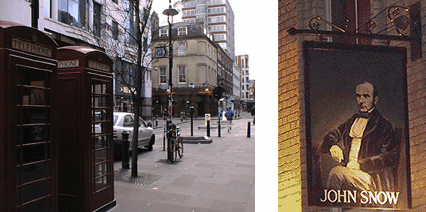
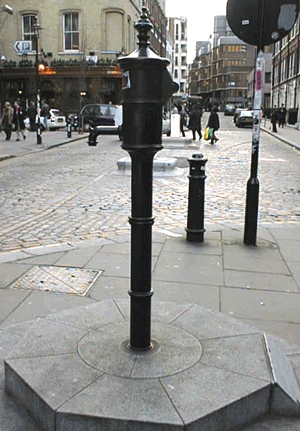
The original Broad Street pump is no longer present, but instead was represented by a pink granite curbstone and small plaque on the side of the John Snow pub.
The replica of the pump was originally created in 1992 to commemorate Snow's work.
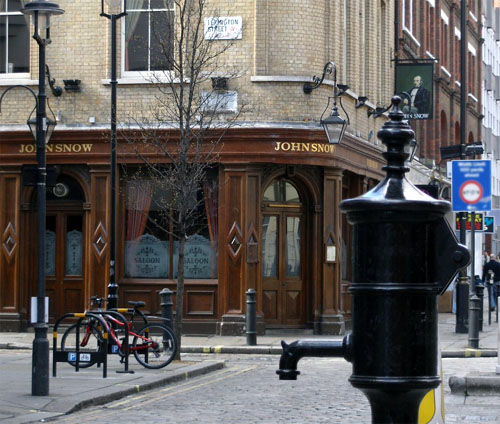
The original plaque (July 20, 1992) at the bottom of the pump describes its importance for those passing by.
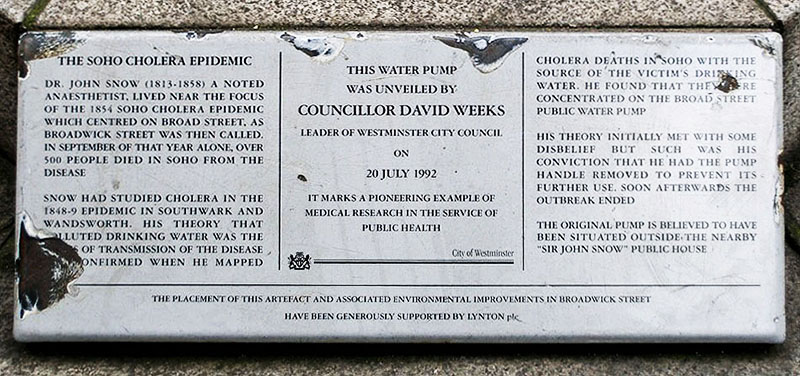
It reads:
Dr. John Snow (1813-1858), a noted anesthesiologist, lived near the focus of the 1854 Soho cholera epidemic which centered on Broad Street, as Broadwick Street was then called. In September of that year alone, over 500 people died in Soho from the disease. Snow had studied cholera in the 1848-49 epidemic in Southwark and Wandsworth. His theory that polluted drinking water was the cause of transmission of the disease was confirmed when he mapped cholera deaths in Soho with the source of the victim's drinking water. He found that they were concentrated on the Broad Street water pump. His theory initially met with much disbelief but such was his conviction that he had the pump handle removed to prevent its further use. Soon afterwards the outbreak ended. The original pump is believed to have been located outside the nearby "Sir John Snow" public house.
Additional views of the John Snow public house (or pub) and the new site of the Broad Street pump replica are presented in the following sections.
THE JOHN SNOW PUB
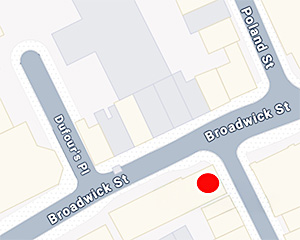

In the early evening when walking East along the short few blocks of Broadwick Street in the Soho region of London, a pump and public house (or pub - red dot) suddenly appear.
The pump with no handle is the former replica of the famous Broad Street pump. "Wick" was added to "Broad" in 1936 to distinguish this short road from other London streets identically named as Broad Street.
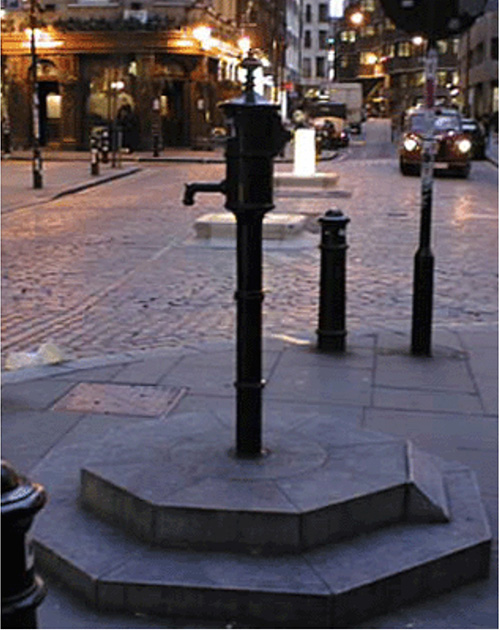
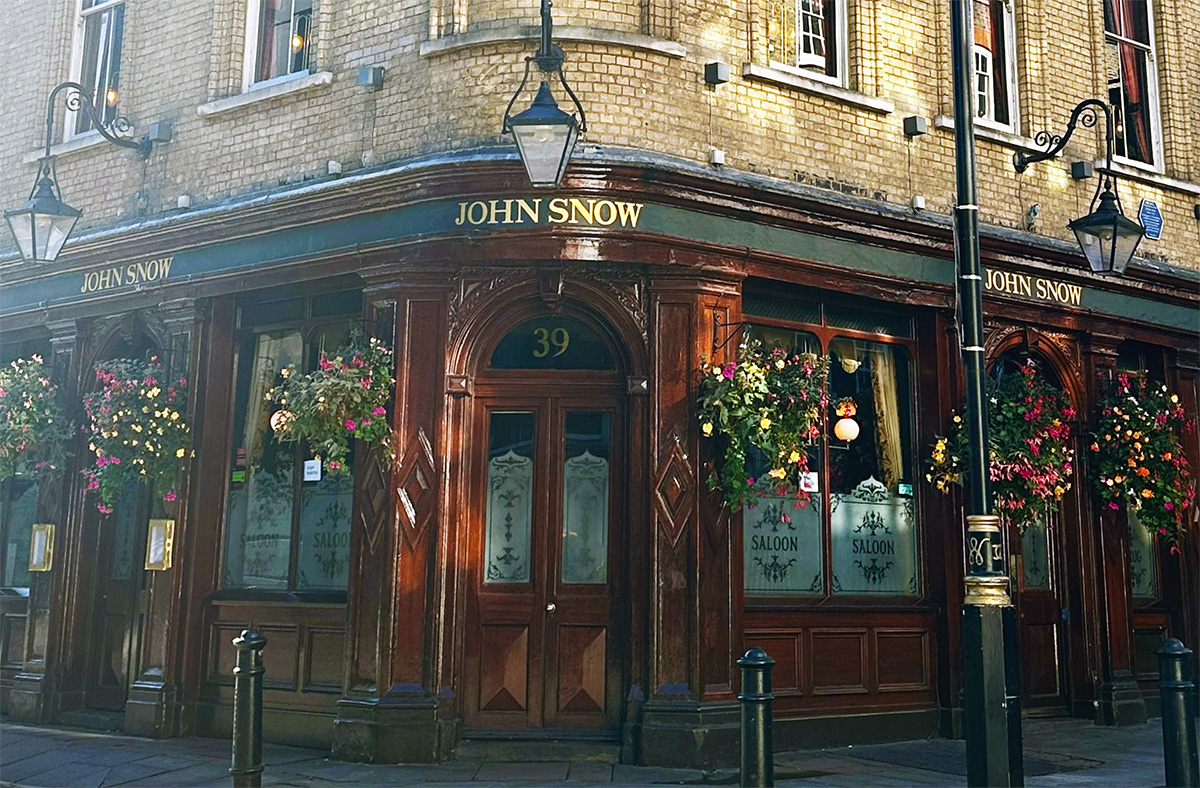
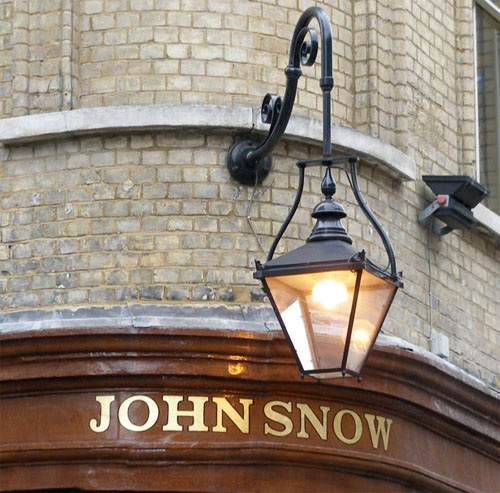
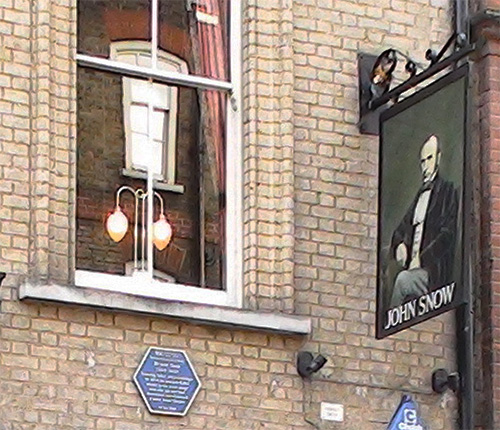
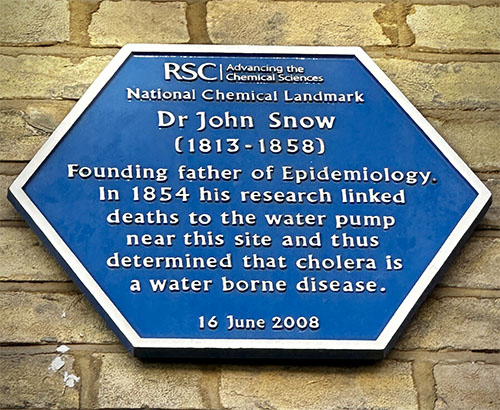
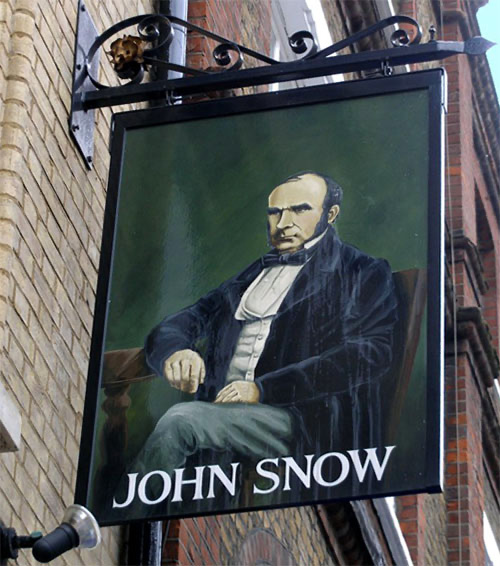
Inside it has all the trappings of a friendly London pub, with beers on tap, simple but typical pub meals, and flowing conversation about John Snow if the occasion warrants.
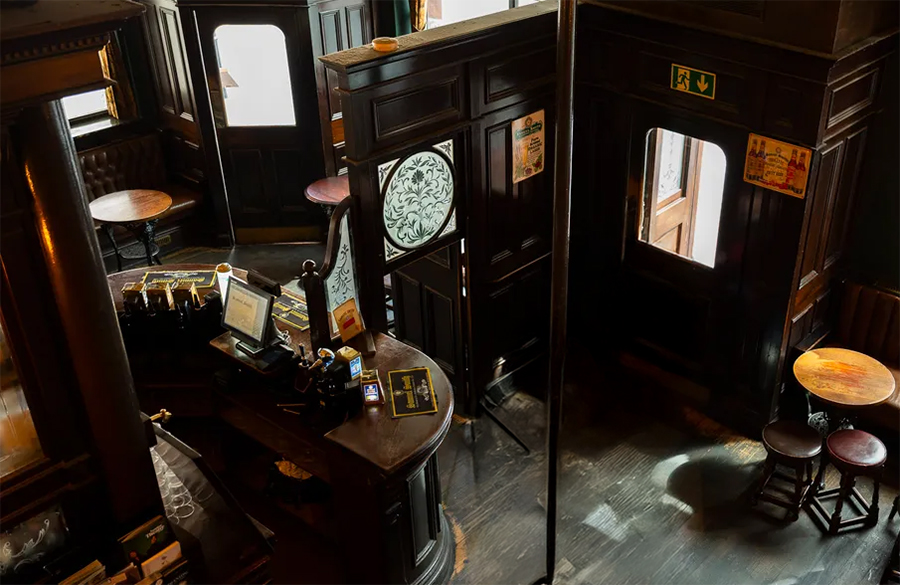
It is the upstairs that is most unique, including the photos on the stairwell wall.
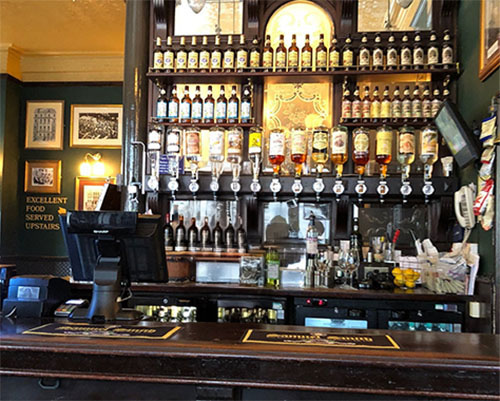
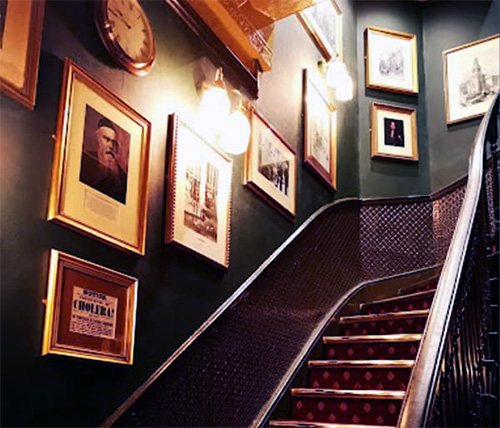
On one wall of the upstairs room is a description of John Snow and the importance of his actions with the Broad Street pump. Also included are several narrative frames which briefly present his seminal work in epidemiology and anesthesiology.
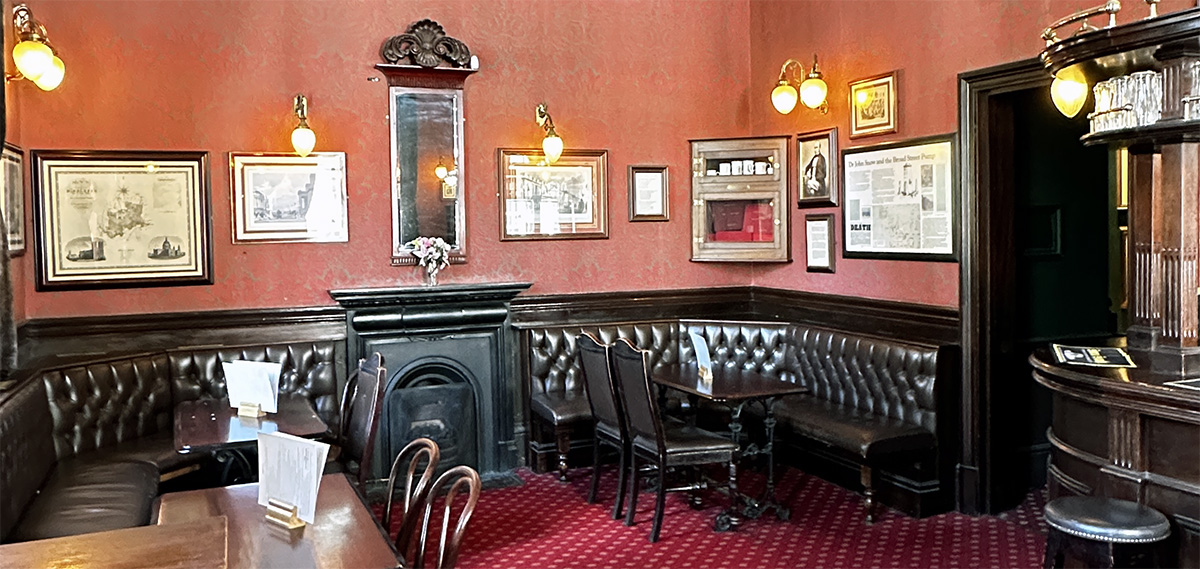
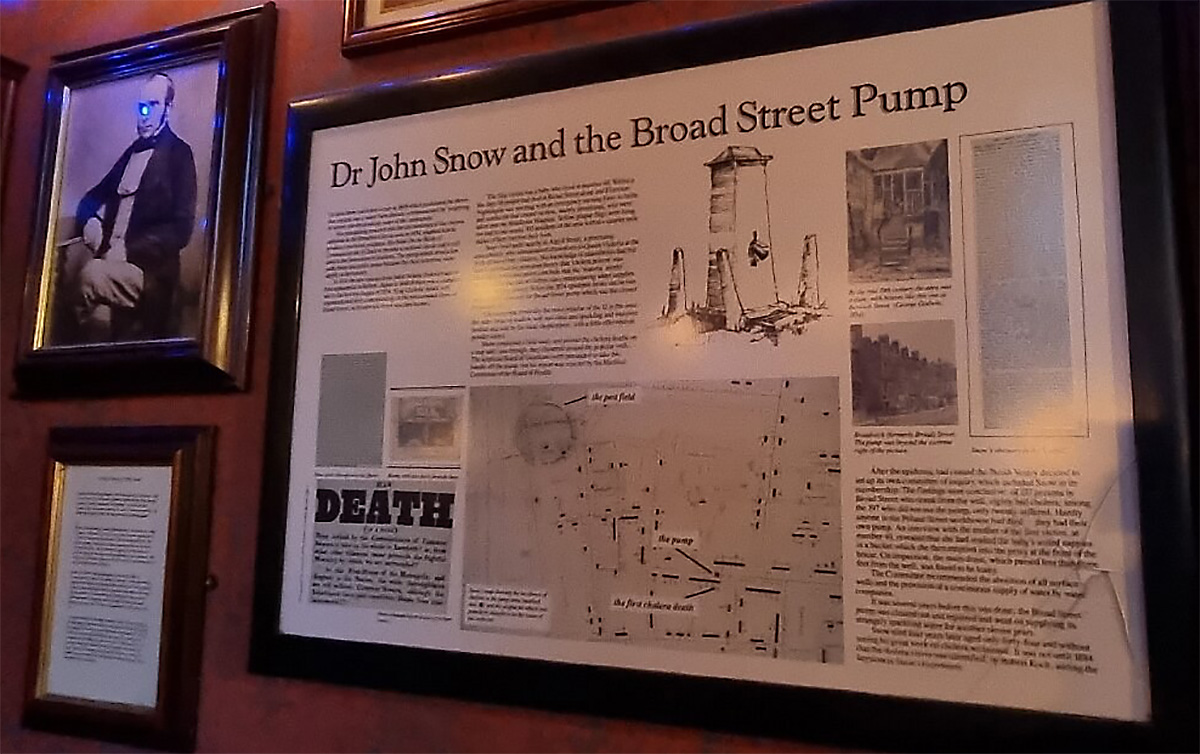
THE BROAD STREET PUMP REPLICA
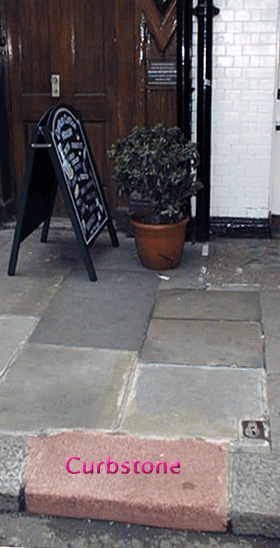
The original replica of the handle-free pump installed in 1992 was some distance from the pink granite curbstone that marked the spot of the actual pump. At that time, a small plaque was mounted on the outside wall of the side of the pub, just above the potted plant, more clearly seen here.
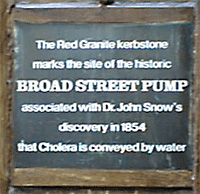
It identified in plain language the importance of this historic site.
Four additional photos were taken in 2006, twelve years before the major update in 2018, offering a more detailed view of the Broadwick Street side of the pub. Also shown is a cleaned up version of the original 1992 plaque to the right of the door, and of course the historic pink curbstone showing where the Broad Street Pump was originally located.
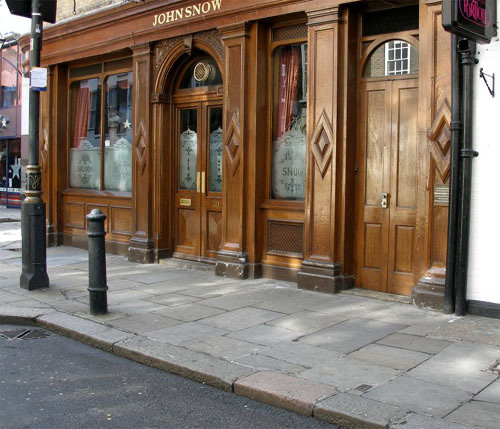
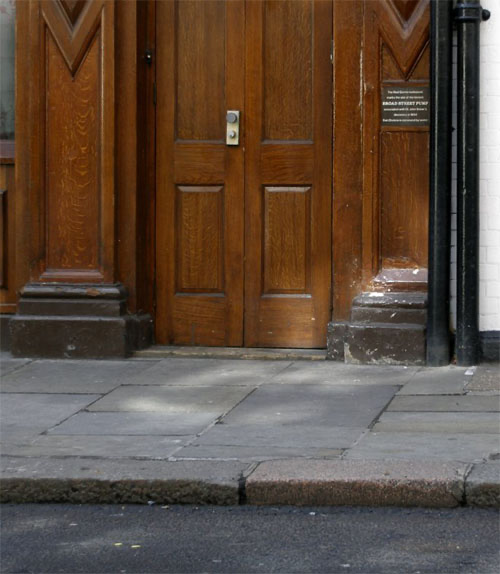
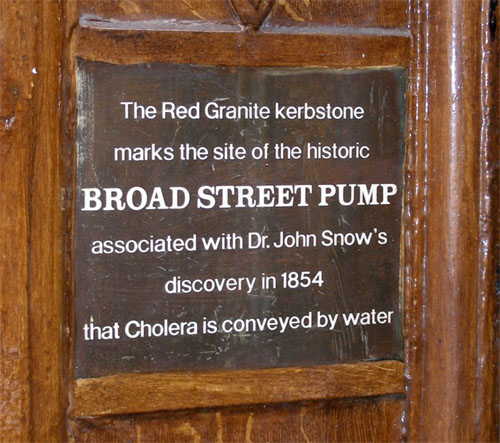
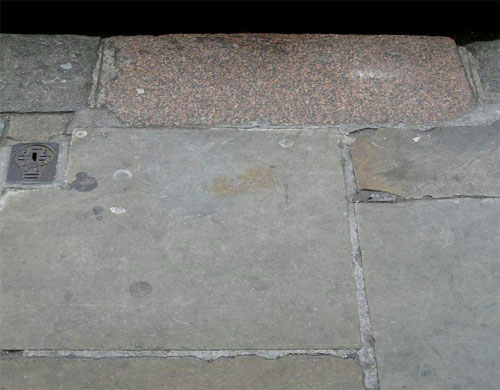
History of the Pub
The building housing the John Snow pub was built in the 1870s and was originally called the "Newcastle-upon-Tyne." Although John Snow was apprenticed in 1827 to a Newcastle-upon-Tyne surgeon (Dr. William Hardcastle), there is no evidence that the previous name of the inn was other than fortuitous.
What was unique about the pub is that it was built at the very site where a water pump had stood, found in 1854 by John Snow to have been the origin of a local cholera outbreak.

While the history of ownership is not clear, The John Snow pub is currently owned and operated by the Samuel Smith Old Brewery in Tadcaster, near York (see 1856 map at right). Theirs was a long-standing family-run enterprise, traditional and thriving in its approach to brewing.
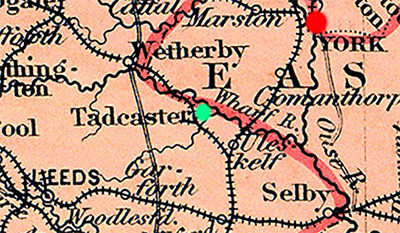
Some time in the late 19th century, the Newcastle-upon Tyne pub was acquired by the Huggins and Co.'s, the same group that owned the brewery on Broad Street where John Snow conducted an important interview (see above). In 1928, the Newcastle-upon-Tyne pub was sold to Watney, Combe, Reid Company, who eventually sold the pub to the current owners, possibly sometime in 1954-56, or even later.
The previous and subsequent owners in the mid-1950s may have heard of Dr. John Snow, although at the time Snow was mainly famous among historians, epidemiologists and others associated with public health. Yet when members of the epidemiological community in London came forth in 1954-55 with stories of John Snow and the significance of the water pump that had been there long ago, changing the name of the pub at a seminal point in history may have caught their attention, especially the future Samuel Smith owners who lived in Tadcaster close to York, John Snow's home town.
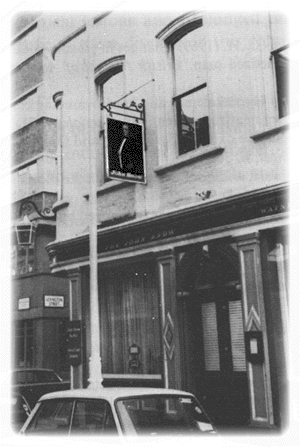
In May 1955, on the occasion of the centenary of John Snow's publishing of On the Mode of Communication of Cholera (1855), the pub name was officially changed to The John Snow. The new inn-sign (at left) was unveiled by Sir Austin Bradford-Hill, then President of the Section of Epidemiology and Preventive Medicine of the Royal Society of Medicine.
Sir Austin Bradford Hill (1897–1991) was a renowned British epidemiologist who established, along with Richard Doll, the causal link between smoking and lung cancer which had a worldwide public health impact. Furthermore, he is known for the "Bradford Hill criteria," a set of guidelines used to determine the strength of a potential causal relationship between a risk factor and a disease. His presence might well have impressed the future pub owners, influencing their decision.
The John Snow Society, established years later in 1992, currently includes The John Snow pub as a meeting place. Members of the society are encouraged to visit the pub when in London, or when attending the society's annual Pump Handle Lecture at the London School of Hygiene and Tropical Medicine (LSHTM).
If John Snow was alive today, he likely would not sip ales and lager in The John Snow pub (although they are reputed to offer non-alcohol beers), being a long-term abstainer from the consumption of alcohol. Yet others appreciate the memories which the pub invokes, as evident in the following short article published in 1997 in The Lancet.
A DOCTOR'S PUB (by T. Raju)
A short walk from London's Piccadilly Circus underground station to the intersection of Broadwick Street and Lexington Street leads to a public house that has a unique medical history connection. It was here some 145 years ago that an important discovery took place.
John Snow (1813-58), the London doctor of obstetric anaesthesia fame, was also an expert in epidemiology with an abiding interest in the study of cholera. During the severe cholera outbreak in 1854 in London, he analysed the geography of water supply and mortality patterns in Soho. There was a disproportionate number of cholera cases in houses supplied by one water company, with nearly 500 cases within a few blocks of a single water pump alone on Broad Street. This pump drew water from the heavily contaminated urban stretch of the Thames as well as a nearby well. Snow found a sewer pipe within a few feet of the well and reasoned that the pipe was contaminating the well and the pump water. The epidemic had started in August, 1854, and the pump handle was removed on Sept 8, but there is much debate about whether its removal halted the epidemic, which had already begun to wane. 6 weeks later the pump was back in use. Nonetheless, this temporary removal has since been hailed as one of the first public-health interventions of the modern era.
But, why a pub now? Over the years urbanisation brought new buildings and new restaurants to Soho. A pub (i.e., The Railway) was built near the site where once stood the well. In 1954, the pub was re-named The John Snow, where a plaque hangs in recognition of Snow's discovery. The irony is that it seems that Snow, a shy and quiet English gentleman, was strictly teetotal.
Demise and Rebirth of the Broad Street Pump
Because of redevelopment plans in the area, the original 1992 replica of the Broad Street Pump was removed in 2015 from its public site, no longer an icon of the neighborhood. The John Snow Society, in collaboration with the Westminster Council, worked actively for three years to return the pump replica to its public location, but this time paying closer attention to its historical location as defined by the pink curbstone, no longer on the present curb (old view below, new view at right).
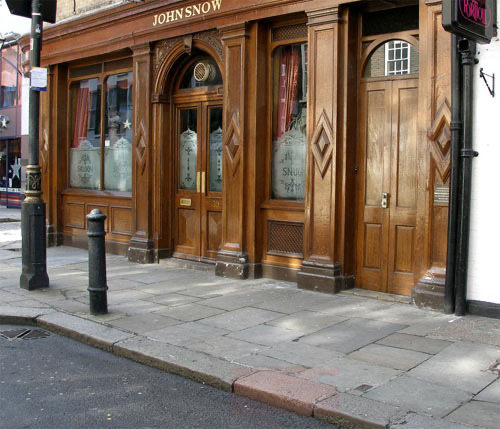
Their efforts on both counts prevailed. On July 20, 2018, the 26-year anniversary of the placement of the original replica, the pump was reinstalled in its historical location.
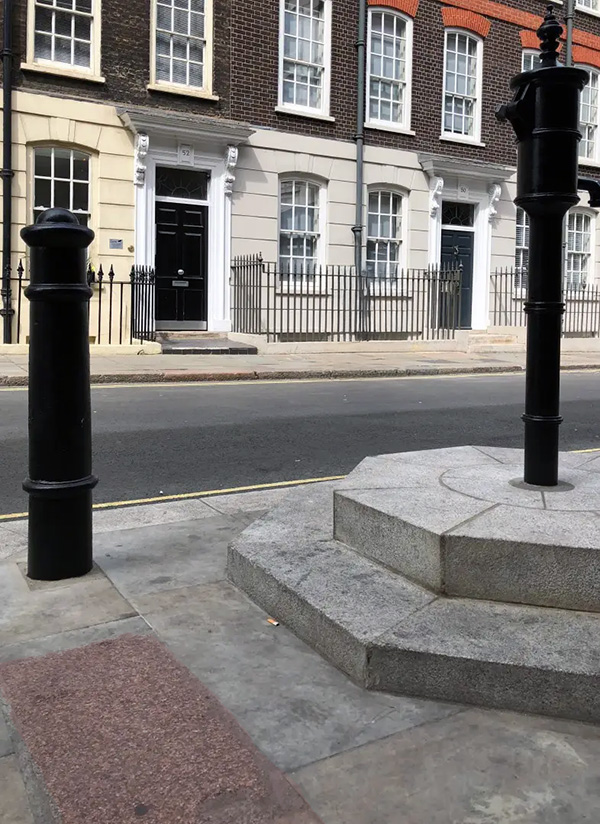
Here is another street-side view of the Broad Street pump and pink curbstone next to the nearby curb post.
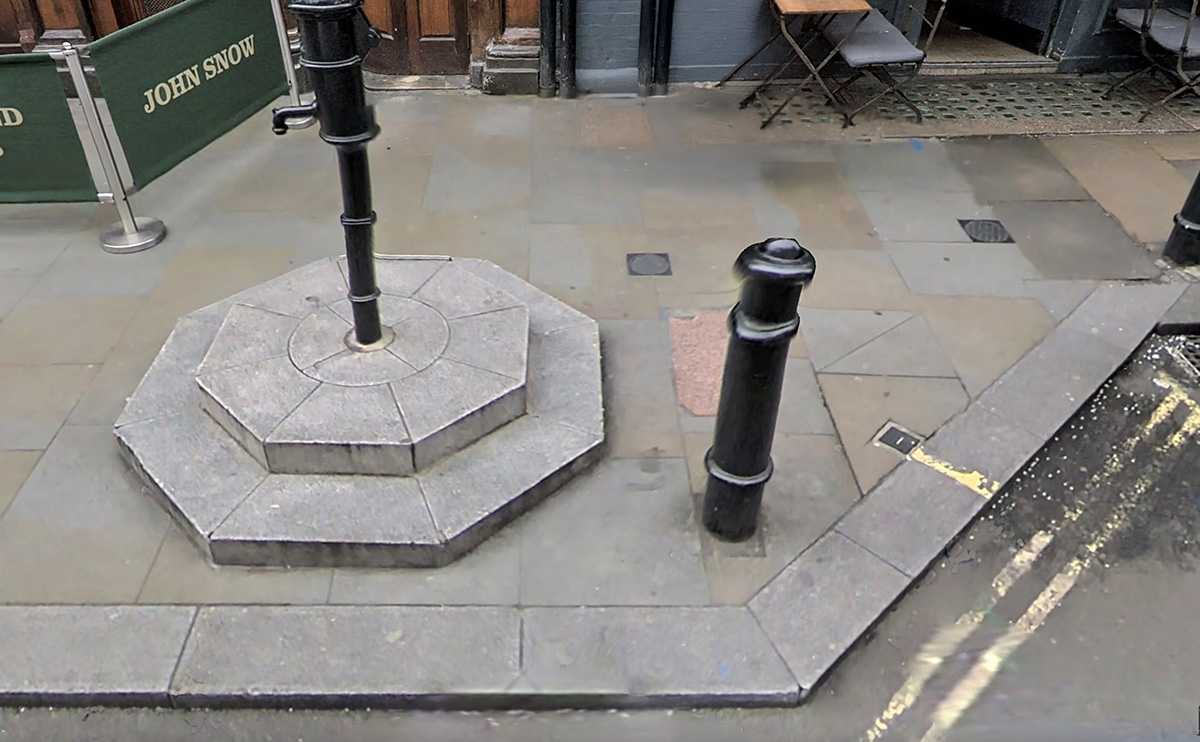
On behalf of Westminster Council, Councillor Richard Beddoe and others officially unveiled the 2018 reinstalment of the Broad Street Pump replica. Speaking as the John Snow Society’s "Pump handle Ambassador", Dr. Ros Stanwell Smith (at right below), Honorary Senior Lecturer at the London School of Hygiene and Tropical Medicine, gave a short speech to commemorate the historical moment. She noted that while it had taken nearly four years to return the curbstone, a positive outcome was that it was now situated closer to the original location of the Broad Street pump.
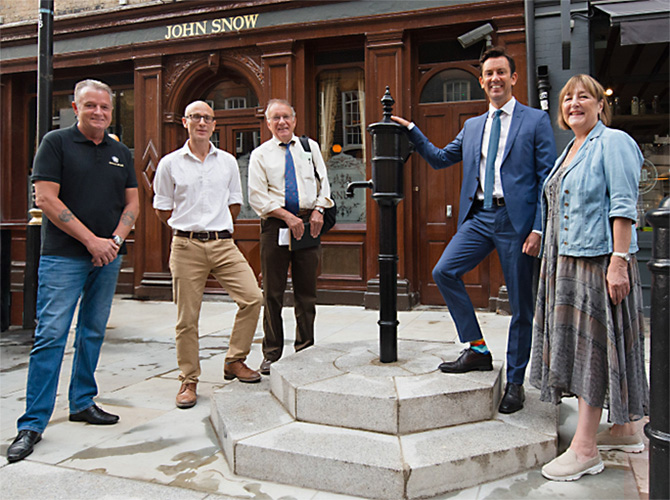
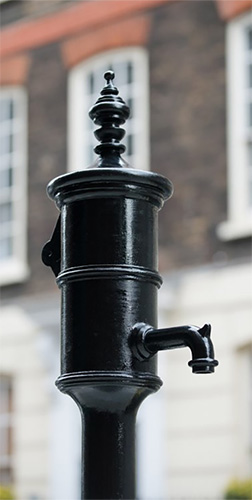
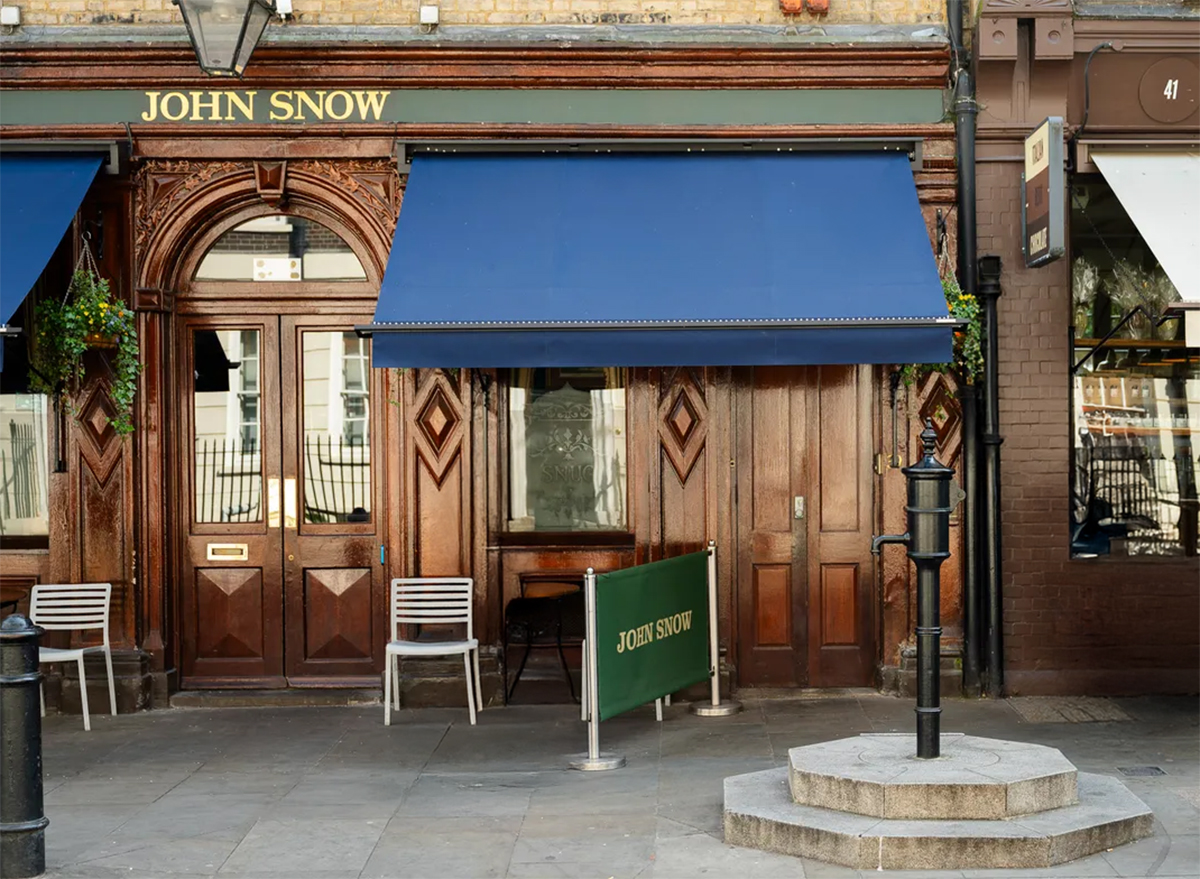
Plaque on Replica of Broad Street Pump - Post 2018
At the base of the replica of the Broad Street pump is a description of the Soho cholera outbreak and Dr. John Snow's role in the removal of the pump handle. The plaque was crafted in 1992 and then re-crafted in 2018 when the replica of the pump was moved to the site of the original pump in John Snow's time, next to the side door of The John Snow Pub on Broadwick Street. In general, the plaque text remains similar to the earlier 1992 version, except for the central panel that describes the July 20, 2018 commemoration and the right panel that addresses the 2018 move to the original historical location.
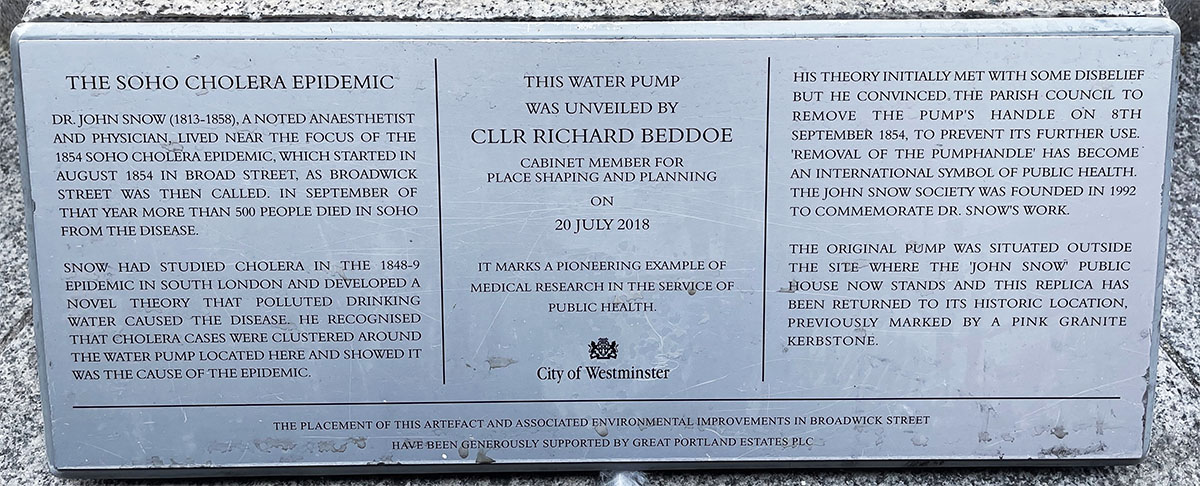
The text reads: Dr John Snow (1813 – 1858) a noted anaesthetist and physician, lived near the focus of the 1854 Soho cholera epidemic, which started in August 1954 in Broad Street, as Broadwick Street was then called. In September of that year more than 500 people died in Soho from the disease.
Snow had studied cholera in the 1848-9 epidemic in South London and developed a novel theory that polluted drinking water caused the disease. He recognised that cholera cases were clustered around the water pump located here and showed it was the cause of the epidemic.
His theory initially met with some disbelief but he convinced the parish council to remove the pump’s handle on 8th September 1854, to prevent its further use. ‘Removal of the pumphandle’ has become an international symbol of public health. The John Snow Society was founded in 1992 to commemorate Snow’s work.
The original pump was situated outside the site where the ‘John Snow’ Public House now stands, and this replica has been returned to its historic location previously marked by a pink granite kerbstone.
This water pump
was unveiled by
Cllr Richard Beddoe
Cabinet Member for
Place Shaping and Planning
On 20 July 2018
It marks a pioneering example of
medical research in the service of
public health
City of Westminster
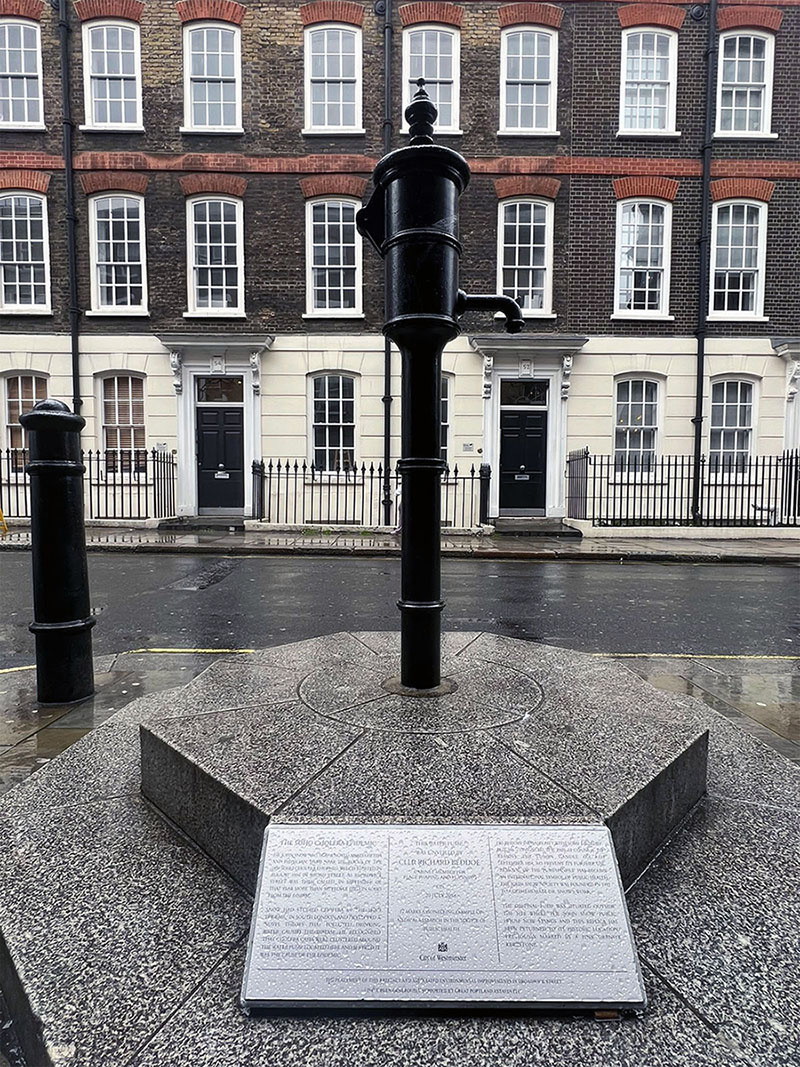
The John Snow sign is on the side of The John Snow Pub building on Broadwick Street. Standing under the sign facing across the street, the pump is now slightly to the left of the sign.
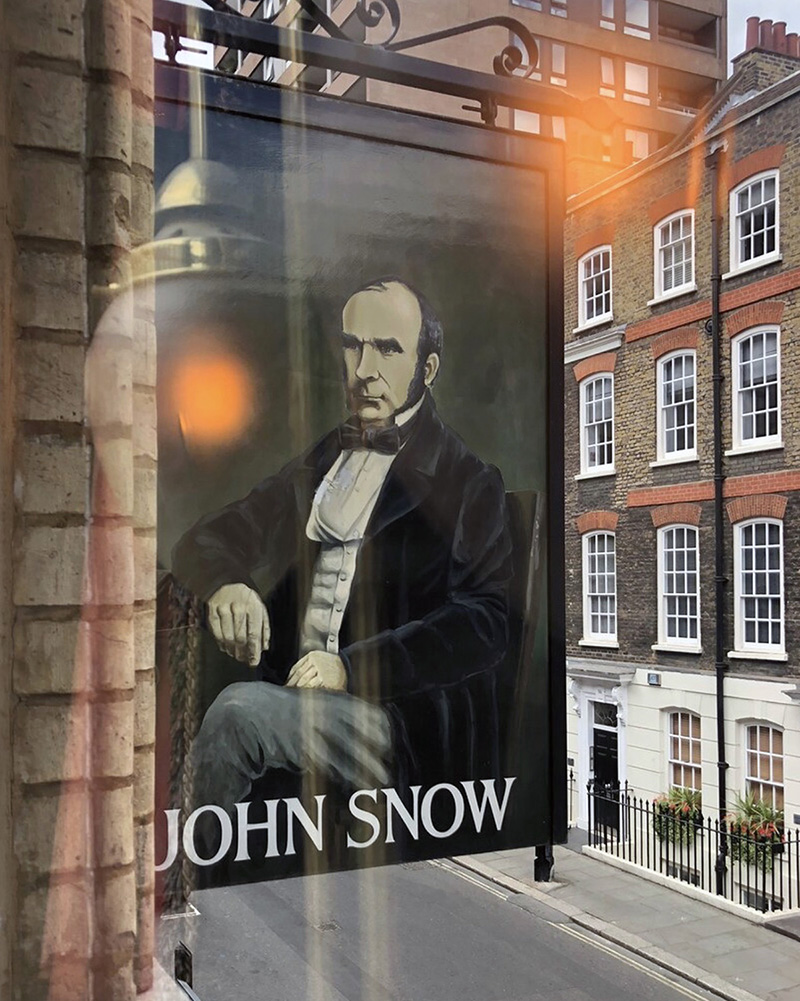
In John Snow's time, the buildings across from the Broad Street Pump were far diferent, using addresses on Broad Steet rather than current Broadwick Street, and the historical set of house numbers. Artist Frederick Calvert (c1785-c1845) painted an undated watercolor of Broad Street across the street from the index case of the 1854 cholera outbreak. Based on other London works by the artist, the watercolor was likely painted in the 1830s-40s. Using the old street numbers provided in Cholera, Chloroform, and the Science of Medicine - A life of John Snow, 2003 and a section of Snow's Map 1, the image below highlights the two buildings directly across the street from the Broad Street Pump and 40 Broad Street where the index case (baby Lewis) and her deceased father resided.
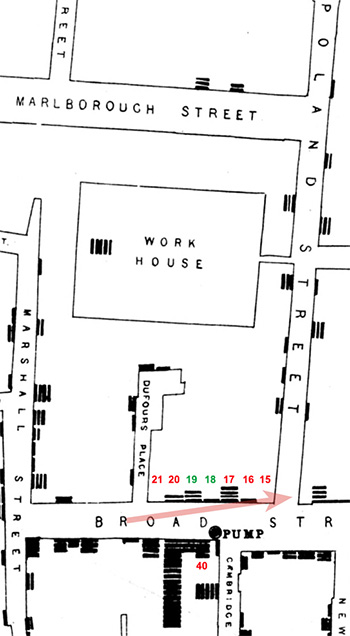
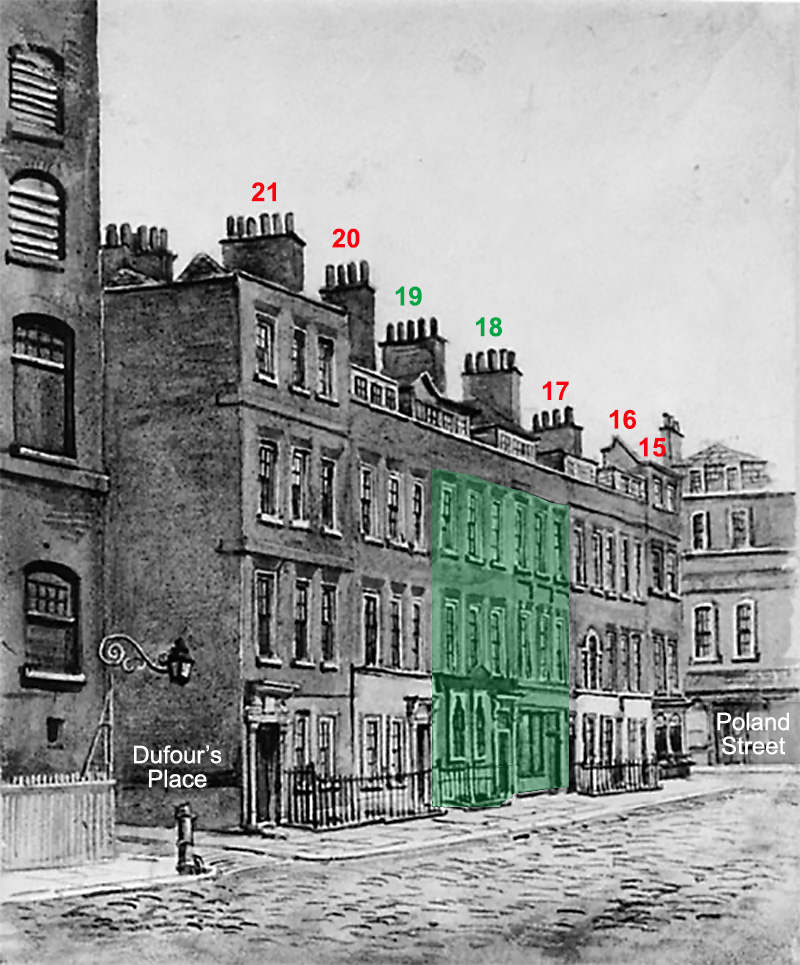
Sources:
